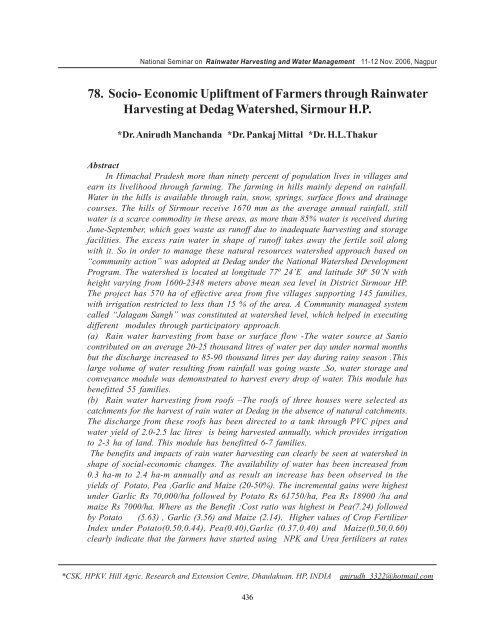Accepted Papers - 3.pdf - UNESCO
Accepted Papers - 3.pdf - UNESCO
Accepted Papers - 3.pdf - UNESCO
Create successful ePaper yourself
Turn your PDF publications into a flip-book with our unique Google optimized e-Paper software.
National Seminar on Rainwater Harvesting and Water Management 11-12 Nov. 2006, Nagpur<br />
78. Socio- Economic Upliftment of Farmers through Rainwater<br />
Harvesting at Dedag Watershed, Sirmour H.P.<br />
*Dr. Anirudh Manchanda *Dr. Pankaj Mittal *Dr. H.L.Thakur<br />
Abstract<br />
In Himachal Pradesh more than ninety percent of population lives in villages and<br />
earn its livelihood through farming. The farming in hills mainly depend on rainfall.<br />
Water in the hills is available through rain, snow, springs, surface flows and drainage<br />
courses. The hills of Sirmour receive 1670 mm as the average annual rainfall, still<br />
water is a scarce commodity in these areas, as more than 85% water is received during<br />
June-September, which goes waste as runoff due to inadequate harvesting and storage<br />
facilities. The excess rain water in shape of runoff takes away the fertile soil along<br />
with it. So in order to manage these natural resources watershed approach based on<br />
“community action” was adopted at Dedag under the National Watershed Development<br />
Program. The watershed is located at longitude 77 0 24’E and latitude 30 0 50’N with<br />
height varying from 1600-2348 meters above mean sea level in District Sirmour HP.<br />
The project has 570 ha of effective area from five villages supporting 145 families,<br />
with irrigation restricted to less than 15 % of the area. A Community managed system<br />
called “Jalagam Sangh” was constituted at watershed level, which helped in executing<br />
different modules through participatory approach.<br />
(a) Rain water harvesting from base or surface flow -The water source at Sanio<br />
contributed on an average 20-25 thousand litres of water per day under normal months<br />
but the discharge increased to 85-90 thousand litres per day during rainy season .This<br />
large volume of water resulting from rainfall was going waste .So, water storage and<br />
conveyance module was demonstrated to harvest every drop of water. This module has<br />
benefitted 55 families.<br />
(b) Rain water harvesting from roofs –The roofs of three houses were selected as<br />
catchments for the harvest of rain water at Dedag in the absence of natural catchments.<br />
The discharge from these roofs has been directed to a tank through PVC pipes and<br />
water yield of 2.0-2.5 lac litres is being harvested annually, which provides irrigation<br />
to 2-3 ha of land. This module has benefitted 6-7 families.<br />
The benefits and impacts of rain water harvesting can clearly be seen at watershed in<br />
shape of social-economic changes. The availability of water has been increased from<br />
0.3 ha-m to 2.4 ha-m annually and as result an increase has been observed in the<br />
yields of Potato, Pea ,Garlic and Maize (20-50%). The incremental gains were highest<br />
under Garlic Rs 70,000/ha followed by Potato Rs 61750/ha, Pea Rs 18900 /ha and<br />
maize Rs 7000/ha. Where as the Benefit :Cost ratio was highest in Pea(7.24) followed<br />
by Potato (5.63) , Garlic (3.56) and Maize (2.14). Higher values of Crop Fertilizer<br />
Index under Potato(0.50,0.44), Pea(0.40),Garlic (0.37,0.40) and Maize(0.50,0.60)<br />
clearly indicate that the farmers have started using NPK and Urea fertilizers at rates<br />
*CSK, HPKV. Hill Agric. Research and Extension Centre, Dhaulakuan. HP, INDIA anirudh_3322@hotmail.com<br />
436

















